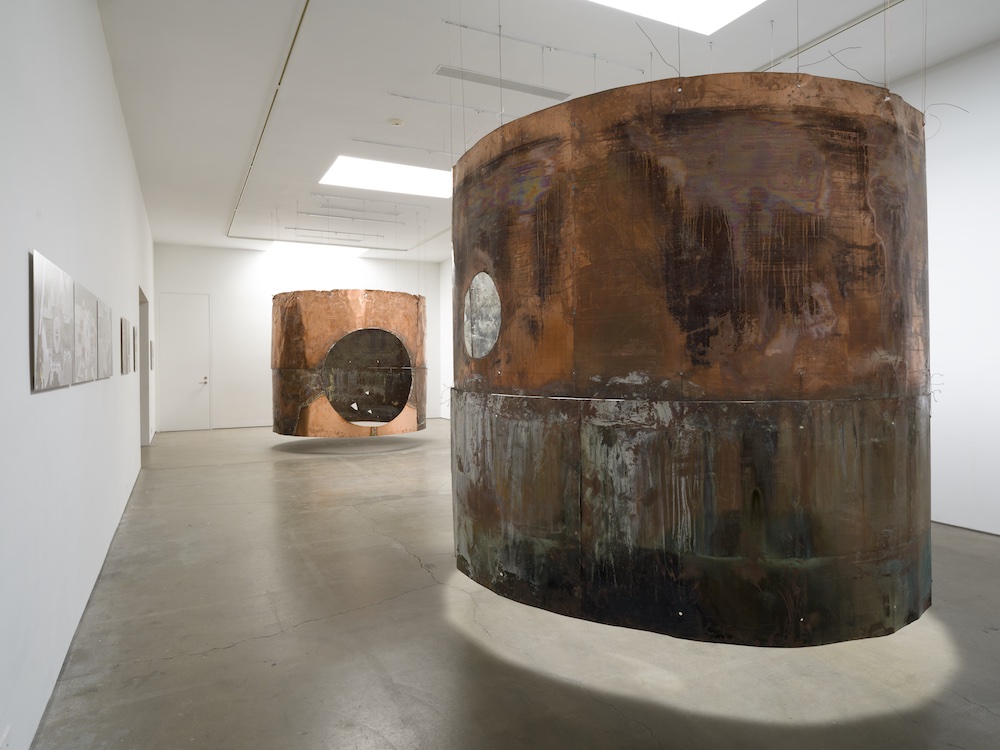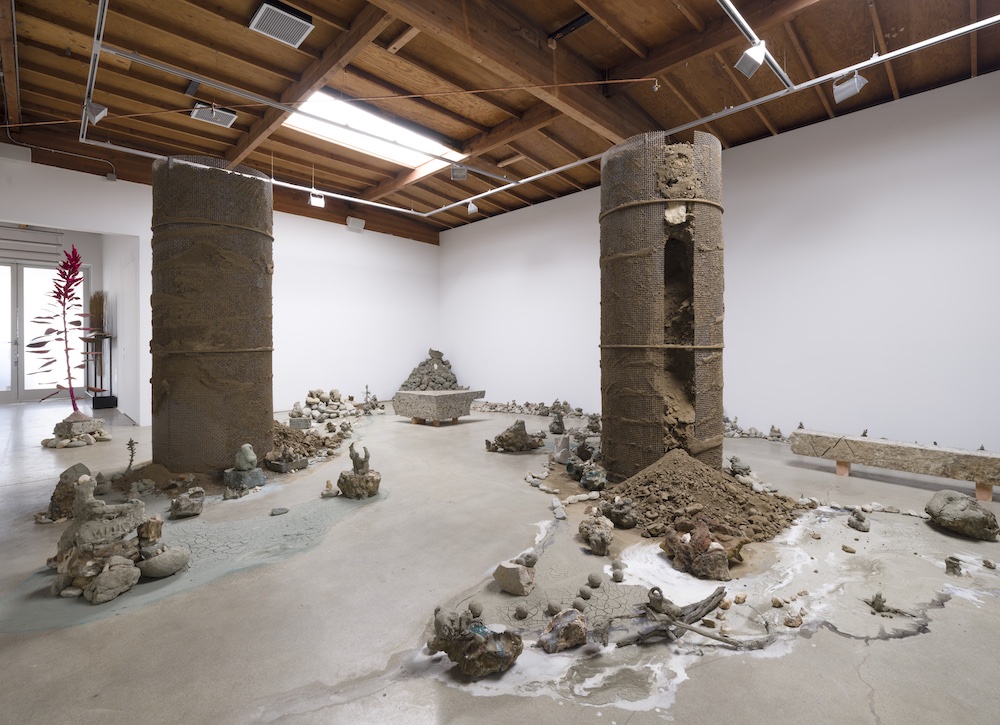If the sculpture of concrete’s last big cultural “moment” (sometime in the 2010s) was typified by figurative and abstract cement statuary that merely winked at its Home Depot provenance, Lauren Bon foregrounds this material in all its blunt, obdurate force. “Concrete Is Fluid” was organized as an informal survey of the artist’s work with Metabolic Studio, the community platform she founded in 2005. Flanking the walls of the gallery’s foyer are three 3,000-pound triangular slabs from a set of 69 such massive puzzle pieces extracted via incisions into the Los Angeles River channel. The channel in question, a straight-shot gray sluice extending from the San Fernando Valley to Long Beach, currently entombs the river that had previously wound its way circuitously through the city. Bon’s strategic removal of chunks of the channel and insertions of copper and clay pipes is part of Metabolic Studio’s “Bending the River” initiative to divert wastewater buried beneath to a treatment center, after which it will be distributed to city parks. The ten-year-old project—aerial maps, photographic documentation, and construction ephemera of which is on view—is an ongoing project to “un-develop” (in the artist’s terms) the industrial landscape that has cropped up around the channel since it was constructed beginning in the 1930s to stem the periodic flooding of the river basin. To this end, Metabolic Studio has purchased over 75 city, state, and federal permits to break through the sheath of concrete and siphon out water buried beneath. Bon also holds the city’s only individual water permit for such use.
Taken cumulatively, the show’s documentary materials propose a brighter future for the river, one that relies not only on environmental consciousness but on the expertise of a dedicated team of scientists, civic planners, and legal consultants, without which its eco-justice mandate could not move forward. All of this, of course, costs money, and it’s worth noting that Bon, the heir to the Annenberg publishing fortune, bankrolls the Studio herself. The project could thus be read as philanthropy, which shouldn’t detract from its considerable achievement as an artwork. One could also argue that in terms of philanthropy, “Bending the River” is a far more useful monument than the endowed museum wings of turn-of-the-century industry barons, or, for that matter, the concrete-cast faux relics of turn-of-another-century artists.

Lauren Bon “Concrete is Fluid,” exhibition view, 2024. Courtesy of Honor Fraser.
In addition to “Bending the River,” Honor Fraser devotes its largest gallery to a room-spanning installation. Meandros (2024), whose title references an ancient Greek pattern symbolizing eternity and unity, featured loose soil, lava rock, and figurative clay forms with crystal quartz. Embedded within and presiding over this installation are Topanga Canyon Soil Landslide Column I and II (both 2024), ten-foot-tall wire mesh columns encasing loose soil from this past spring’s landslides; the structures were regularly irrigated by overhead sprinklers using water from nearby Bolona Creek. Meandros’s small sculptures, ritually crafted by Bon and collaborators and listed in the show’s press release as “birthing figures,” are clustered below them. The clay for these figures, sourced from the LA riverbed during “Bending the River’s” excavation process, gradually merged with the seeping landslide dirt over the course of the exhibition’s run, while plants latent within the displaced soil’s seedbank germinated and sprouted.
How to square the precise methodology of “Bending the River” with the stone and crystal “birthing figures” that hold court in Meandros? The crafting of these figures may have been meaningful for their creators, but to my mind it did little for the river. Perhaps that’s my own failure of imagination. The divide between epistemological and mystical conduits for making sense of the world remains as entrenched as that between the concrete landscape and the clay floodplain beneath it. While the show’s accompanying text espouses the virtues of “adaptive reuse” of manmade structures, a confluence of concrete and clay, the experience of “Bending the River” landed me definitively in favor of native fauna over concrete jungles as a means of flood and landslide prevention. (Many ecologically conscious artists and architects have in recent years stopped using concrete in light of the catastrophic ecological effects—soil erosion chief among them—caused by the extraction of the sand used to make it.) Ultimately, the figurative sculptures, the land-art columns, and the slabs themselves registered less as sculptures and more as placeholders or placards to draw our attention to the monumental task of restoration.


